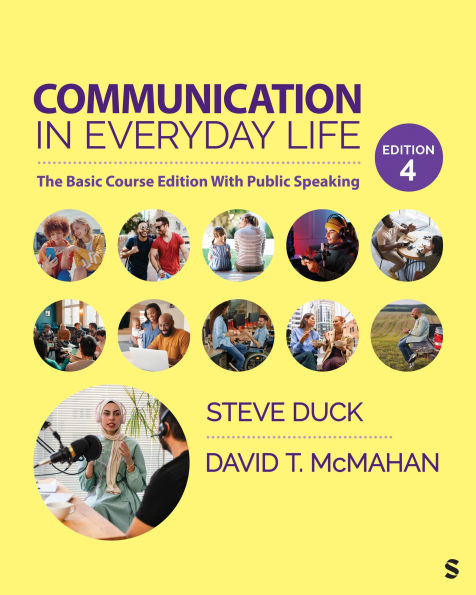Communication in Everyday Life: The Basic Course Edition With Public Speaking
Communication in Everyday Life: The Basic Course Edition With Public Speaking offers an engaging look at the inseparable connection between relationships and communication. Authors Steve Duck and David T. Mc Mahan combine theory and application to introduce readers to fundamental communication concepts. Their book provides a strong foundation in communication concepts, theory, and research, while helping readers master practical communication skills, such as listening and critical thinking, using technology to communicate, understanding nonverbal communication, creative persuasive strategies, and managing group conflict. The Fourth Edition includes practical instruction on communicating interpersonally, in groups, in interviews and on making effective presentations. The authors inspire learners to think critically, connect communication theory to their own experiences, and enhance their communication skills along the way.
Also available in Sage Vantage, an intuitive learning platform that integrates quality Sage textbook content with assignable multimedia activities and auto-graded assessments to drive student engagement and ensure accountability. Learn more about 978-1-0719-1570-7, Communication in Everyday Life: The Basic Course Edition With Public Speaking- Vantage Digital Option, Fourth Edition.
1116786540
Also available in Sage Vantage, an intuitive learning platform that integrates quality Sage textbook content with assignable multimedia activities and auto-graded assessments to drive student engagement and ensure accountability. Learn more about 978-1-0719-1570-7, Communication in Everyday Life: The Basic Course Edition With Public Speaking- Vantage Digital Option, Fourth Edition.
Communication in Everyday Life: The Basic Course Edition With Public Speaking
Communication in Everyday Life: The Basic Course Edition With Public Speaking offers an engaging look at the inseparable connection between relationships and communication. Authors Steve Duck and David T. Mc Mahan combine theory and application to introduce readers to fundamental communication concepts. Their book provides a strong foundation in communication concepts, theory, and research, while helping readers master practical communication skills, such as listening and critical thinking, using technology to communicate, understanding nonverbal communication, creative persuasive strategies, and managing group conflict. The Fourth Edition includes practical instruction on communicating interpersonally, in groups, in interviews and on making effective presentations. The authors inspire learners to think critically, connect communication theory to their own experiences, and enhance their communication skills along the way.
Also available in Sage Vantage, an intuitive learning platform that integrates quality Sage textbook content with assignable multimedia activities and auto-graded assessments to drive student engagement and ensure accountability. Learn more about 978-1-0719-1570-7, Communication in Everyday Life: The Basic Course Edition With Public Speaking- Vantage Digital Option, Fourth Edition.
Also available in Sage Vantage, an intuitive learning platform that integrates quality Sage textbook content with assignable multimedia activities and auto-graded assessments to drive student engagement and ensure accountability. Learn more about 978-1-0719-1570-7, Communication in Everyday Life: The Basic Course Edition With Public Speaking- Vantage Digital Option, Fourth Edition.
156.0
Pre Order
5
1

Communication in Everyday Life: The Basic Course Edition With Public Speaking
440
Communication in Everyday Life: The Basic Course Edition With Public Speaking
440Paperback(Fourth Edition)
$156.00
156.0
Pre Order

Product Details
| ISBN-13: | 9781071915363 |
|---|---|
| Publisher: | SAGE Publications |
| Publication date: | 07/31/2025 |
| Edition description: | Fourth Edition |
| Pages: | 440 |
| Product dimensions: | 8.00(w) x 10.00(h) x (d) |
About the Author
From the B&N Reads Blog
